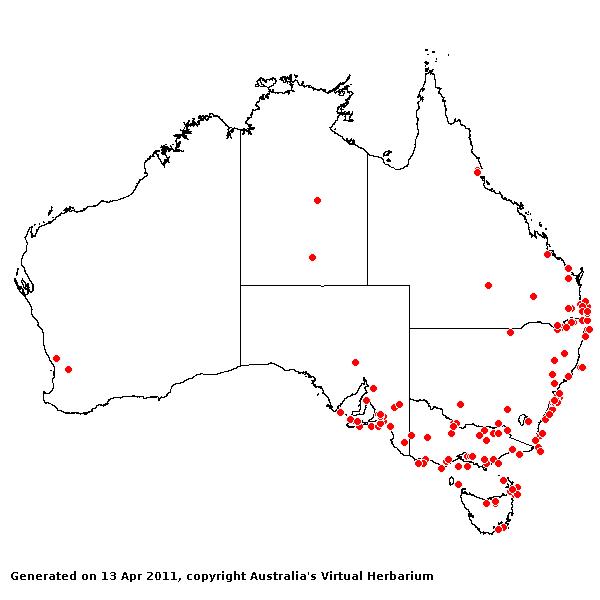Cenchrus clandestinus*
(Hochst. ex Chiov.) Morrone.
Ann. Bot. 106: 127 (2010). Classification. (GPWG 2001) : Subfamily
Panicoideae. Paniceae.
Basionym and/or
Replacement Name: Pennisetum
clandestinum Hochst. ex Chiov., Ann. Ist. Bot. Roma, viii. 41, in
adnot. (1903).
Type of Basionym or
Protologue Information: HT: Schimper 2084, Ethiopia (FI;
IT: K).
Recent synonyms:
Kikuyochloa clandestina.
Key references
(books and floras): [1952] C.A.Gardner, Flora of Western Australia 1
Gramineae (281) as Pennisetum clandestinum, [2002] D.Sharp & B.K.Simon, AusGrass, Grasses of
Australia as Pennisetum clandestinum, [2002] J.Wheeler, N.Marchant & M.Lewington, Flora of the
South West (426) as Pennisetum clandestinum, [2006] J.Jessop, G.R.M.Dashorst, F.M.James, Grasses of
South Australia (471) as Pennisetum clandestinum, [2008] S.W.L.Jacobs, R.D.B.Walley &
D.J.B.Wheeler, Grasses of New South Wales (333) as Pennisetum clandestinum.
Illustrations:
[2006] J.Jessop, G.R.M.Dashorst, F.M.James, Grasses of South Australia (471, Fig. 404) as Pennisetum clandestinum, [2008] S.W.L.Jacobs,
R.D.B.Whalley & D.J.B.Wheeler, Grasses of New South Wales, 4th edn
(332) as Pennisetum clandestinum.
Habit.
Perennial. Rhizomes present, elongated. Stolons present. Culms prostrate,
3–15(–45) cm tall. Ligule a fringe of hairs. Leaf-blades flat or conduplicate,
1–15 cm long, 1–5 mm wide.
Inflorescence.
Inflorescence solid, a raceme (of 2–4 spikelets and concealed within the
subtending sheath).
Spikelets.
Spikelets sessile, 1 in the cluster. Involucre composed of bristles. Fertile
spikelets 2-flowered, the lower floret barren (rarely male), the upper fertile,
comprising 1 basal sterile florets, comprising 1 fertile floret(s), without
rachilla extension, lanceolate, dorsally compressed, 10–20 mm long.
Glumes. Glumes
thinner than fertile lemma. Upper glume ovate, 0–3 mm long, hyaline, without
keels, 0 -nerved. Florets. Basal sterile florets 1, barren, without
significant palea. Lemma of lower sterile floret 100 % of length of spikelet,
membranous, 8–12 -nerved.
Fertile lemma 10–20 mm
long, without keel, 8–12 -nerved. Palea 2–4 -nerved. Lodicules absent or
vestigial. Anthers 3.
Continental
Distribution: Africa, Temperate Asia, Tropical Asia, Australasia, Pacific,
North America, and South America.
Australian
Distribution: Western Australia, South Australia, Queensland, New South
Wales, Victoria, Tasmania, Norfolk I, Lord Howe.
Western Australia: Drummond. South
Australia: North-western, Gairdner-Torrens Basin, Flinders Ranges, Eyre
Peninsula, Murray, Yorke Peninsula, Southern Lofty, Kangaroo Island,
South-eastern. Queensland: Darling
Downs, Moreton, Port Curtis, South Kennedy, Leichhardt, Wide Bay.
New South Wales: North
Coast, Central
Coast, South Coast,
Central-Western Slopes, South-Western Slopes. Victoria: East Gippsland,
Eastern Highlands, Gippsland Plain, Lowan Mallee, Midlands, Murray Mallee,
Otway Plain, Otway Range, Riverina, Volcanic Plain, Wannon, Wimmera. Tasmania: King
Island, Furneaux Group, East Coast.
Notes.
The reduced and modified nature of the inflorescence and spikelets may result
from reliance on vegetative reproduction from the pronounced stolons and
rhizomes. This species could become a troublesome weed in tropical regions.
Introduced. In
tropical and subtropical wet sclerophyll forests, Brigalow forests, tropical
and subtropical sub-humid woodlands, semi-arid shrub woodlands, and arid and
semi-arid low woodlands. Flowers sporadically throughout the year.




